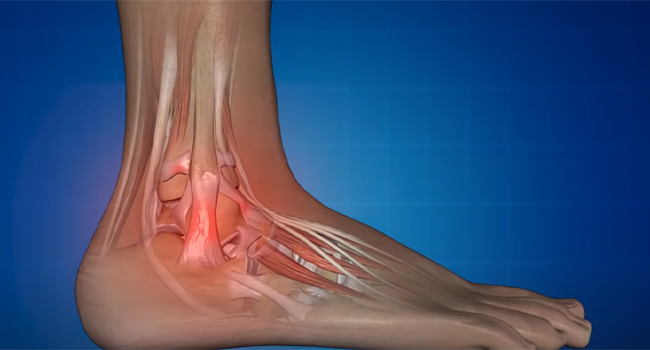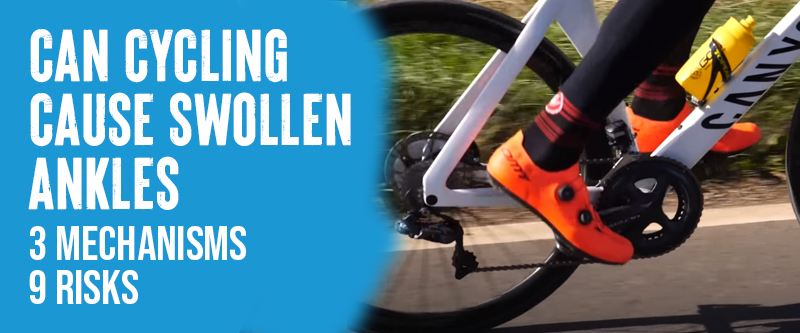Swollen ankles, or edema, result from fluid accumulation around the ankles, causing swelling. Causes include prolonged sitting or standing, excessive salt intake, obesity, pregnancy, certain medications, or underlying health conditions like the kidney, liver, or heart problems cycle.
Yes, cycling can cause swollen ankles. The repetitive motion of pedaling exerts continuous pressure on the tibial nerve in the lower leg, leading to inflammation, swelling, and persistent pain.
This is known as peripheral edema, which can affect various body parts, including the lower and upper extremities, and even areas like the eyelids or face. It may occur during strenuous exercise.
We’ll explore why cycling can cause swollen ankles and provide helpful tips to keep you riding comfortably.
Can Cycling Cause Swollen Ankles: Mechanisms & 9 Risks

While cycling has many health benefits, cyclists must take necessary measures to prevent ankle swelling. We delve into the mechanisms responsible for swollen ankles during cycling.
Increased Blood Flow to the Lower Body
Cycling involves continuous pedaling, which increases the circulation in the legs, including the ankles. The increased blood flow leads to the accumulation of fluids in the ankles, causing swelling. This is sometimes a good thing.
Adequate blood flow to our lower body is essential for our well-being. Still, prolonged periods of cycling can cause too much blood flow, which ultimately leads to inflammation.
Compression of Veins and Lymphatic Vessels
The leg’s veins and lymphatic vessels return fluids to the heart. When cycling, the compression of these vessels by the cycling gear and the bike seat leads to a reduced rate of fluid drainage from the legs.
This can accumulate fluid in the legs, causing swelling. The muscles in the lower legs help pump fluids from the feet to the heart. Prolonged inactivity during cycling reduces muscle activity, reducing fluid pump action and ultimately adding to ankle swelling.
Effects of Gravity and Inactivity
Nothing escapes the effects of gravity during cycling. Gravity pulls fluids down to the ankles, where they accumulate and lead to swelling. The static position and lack of muscle movement during cycling also contribute to ankle swelling.
As muscles contract and relax, fluids get pumped out of the legs, which reduces the chances of fluid accumulation in the ankles. Prolonged cycling periods lead to reduced muscle movement, increasing the incidence of swollen ankles.
Cycling and Swollen Ankles: 9 Risks
Swollen ankles are a common issue for cyclists, and they can negatively affect performance and overall health. We will explore the risks associated with swollen ankles during cycling.
Increased Risk of Injury
Swollen ankles can mean several things, including muscle fatigue, inflammation, or an underlying injury. Here are some injury risks associated with swollen ankles in cyclists:
- Ankle sprains: Repeated swelling can weaken the tissues, making ankle sprains more likely.
- Shin splints: Swollen ankles can affect the lower leg’s biomechanics and contribute to shin splints or tibial stress fractures.
- Achilles tendonitis: The Achilles tendon can inflame because of the stress put on it during cycling, leading to swelling.
Impact on Performance
Muscle fatigue caused by the added pressure on the ankle joint can adversely affect a cyclist’s performance. Swollen ankles can lead to decreased mobility, soreness, and pain. Here are some performance risks associated with swollen ankles:
- Reduced speed: Swollen ankles reduce flexibility and stabilizing ability, leading to slower cycling speeds.
- Impaired balance: Swelling in the ankles can make balance more challenging, especially when standing on the pedals.
- Delayed recovery: Prolonged swelling in the ankle can increase recovery times, affecting your training consistency.
Long-Term Health Risks
Suppose the cause of your swollen ankles goes unaddressed. In that case, the long-term damage may be irreversible, leading to some of the following risks:
- Osteoarthritis: Repeated swelling can cause cartilage damage, leading to osteoarthritis with chronic pain.
- Chronic inflammation: Chronic swelling puts you at risk for developing chronic inflammation, leading to various chronic illnesses.
- Blood clots and vein damage: Chronic swelling in the ankles can lead to blood clots and vein damage, leading to various vascular diseases.
Swollen Ankles Caused By Cycling: 5 Contributing Factors
Cyclists may experience swollen ankles during or after a ride. This can be uncomfortable and even painful, raising questions about whether cycling is the cause. We will explore the factors contributing to swollen ankles during cycling.
Age
We undergo several physical changes as we age, including decreased muscle mass and overall fitness level. These changes can affect our posture and balance, making it more challenging to maintain proper form while cycling.
As we age, our veins and lymphatic systems may also weaken, making it more difficult for fluids to circulate and leading to swelling in the ankles.
Level of Fitness
If you’re new to cycling or have taken a break from your regular riding routine, it’s crucial to build strength to avoid discomfort and swelling in your ankles. Pushing yourself too hard and quickly can cause overuse injuries and inflammation, affecting your ankles and other body parts.
Type of Bicycle and Shoes

The type of bicycle and footwear you use extensively prevents or exacerbates ankle swelling during cycling. If your bike seat is too high or too low, it can affect your pedaling form and increase pressure on your ankles.
Shoes that don’t fit correctly or need to provide more support can lead to poor alignment and swelling.
Duration and Intensity of Cycling
The length and intensity of your rides can also affect ankle swelling. Cycling for extended periods or with high intensity can cause muscle fatigue, leading to inflammation and swelling. Taking breaks during your ride, pacing yourself, and accumulating your workouts can all help to prevent this.
Weather and Environment
Environmental factors like temperature, humidity, and altitude can contribute to swollen ankles during cycling. Hotter temperatures and higher altitudes cause dehydration, making it harder for your body to regulate fluids properly and increasing your risk of swelling.
Swollen Ankles After Cycling: 4 Tips for Prevention
Several factors, such as dehydration, improper bicycle setup, or strenuous exercise, can cause a swelling ankle. We will discuss preventive measures to avoid swollen ankles while cycling.
Proper Hydration and Nutrition
One of the most effective ways to prevent swollen ankles from cycling is to stay hydrated and maintain a balanced diet. Dehydration can cause fluid retention, leading to swollen ankles, among other health issues. Here are some tips for proper hydration and nutrition during cycling:
- Drink plenty of water before, during, and after your cycling session.
- Avoid sugary drinks that can cause dehydration.
- Consuming foods rich in potassium is essential since this mineral regulates fluid balance in the body.
Correct Bicycle Setup and Maintenance
Another critical factor in preventing swollen ankles during cycling is ensuring that your bicycle is correctly and well-maintained. Here are some tips:
- Ensure your bike saddle is at the right height to avoid putting too much pressure on your ankles.
- Check your bike tires regularly, as under-inflated tires can make pedaling harder and put more strain on your ankles.
- Adjust your pedals to keep your feet in a natural position while cycling.
Compression Gear and Elevation
Compression gear and elevation can also help prevent swollen ankles during cycling. Compression gear, such as compression socks, can help improve blood flow and reduce swelling. Elevation can also help reduce swelling, improving fluid drainage from the legs and feet. Here are some tips for using compression gear and height:
- Wear compression socks or other gear during cycling to enhance blood flow and reduce swelling.
- Elevate your legs above your heart level after cycling to promote the drainage of excess fluid and reduce swelling.
Stretching and Strengthening Exercises

Stretching and strengthening exercises prevent swollen ankles by improving the flexibility and strength of the ankle muscles. Here are some activities to consider:
- Ankle circles: Lie down with your feet off the ground. Rotate your ankles slowly in a circular motion.
- Calf raises: Stand shoulder-width apart, rise on your toes, and back down.
- Toe taps: Sit with your legs extended and your feet off the ground. Alternately tap your toes on the floor.
Conclusion
While swollen ankles during cycling can be uncomfortable, they are often preventable. Understanding the mechanisms behind edema during cycling and taking necessary precautions such as proper hydration and nutrition, correct bicycle setup and maintenance, and stretching and strengthening exercises.
You can prevent swollen ankles on your next ride. Caring for your body is essential to a safe and enjoyable cycling experience. So, hop on that bike and ride safely and comfortably.
FAQs
Is Cycling Able to Cause Water Retention?
Stress on your muscle fibers during challenging rides and heavy lifting sessions can cause micro-tears, resulting in inflammation, an essential part of the healing and repair process. Your body keeps fluid as a response. While it’s not permanent, it can persist until you adjust to your new routine.


